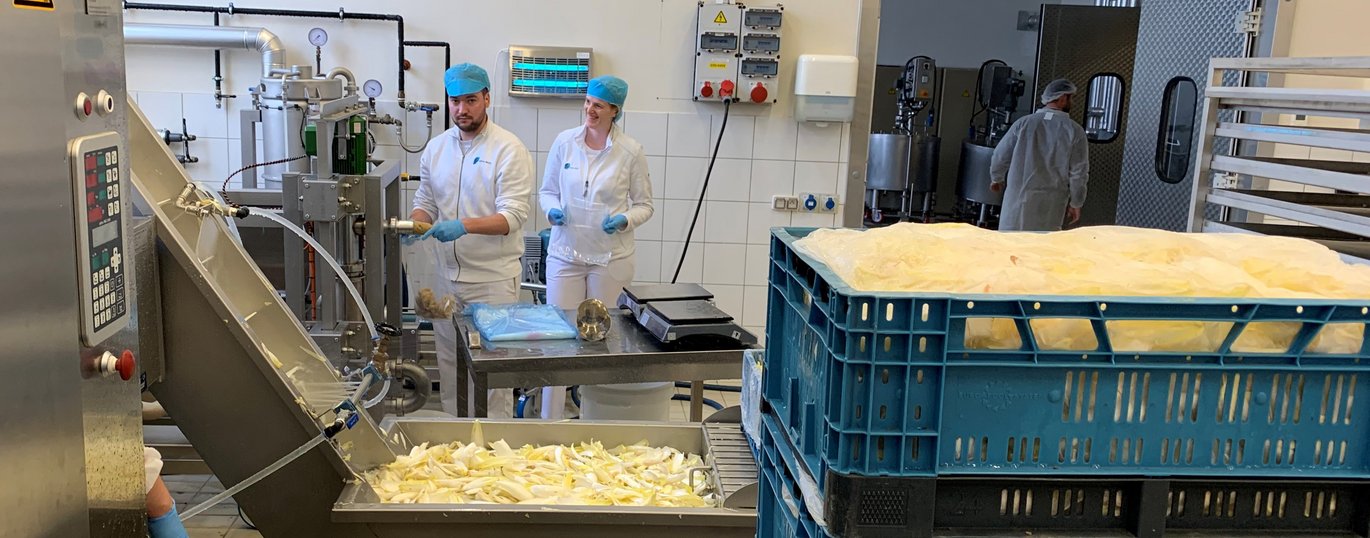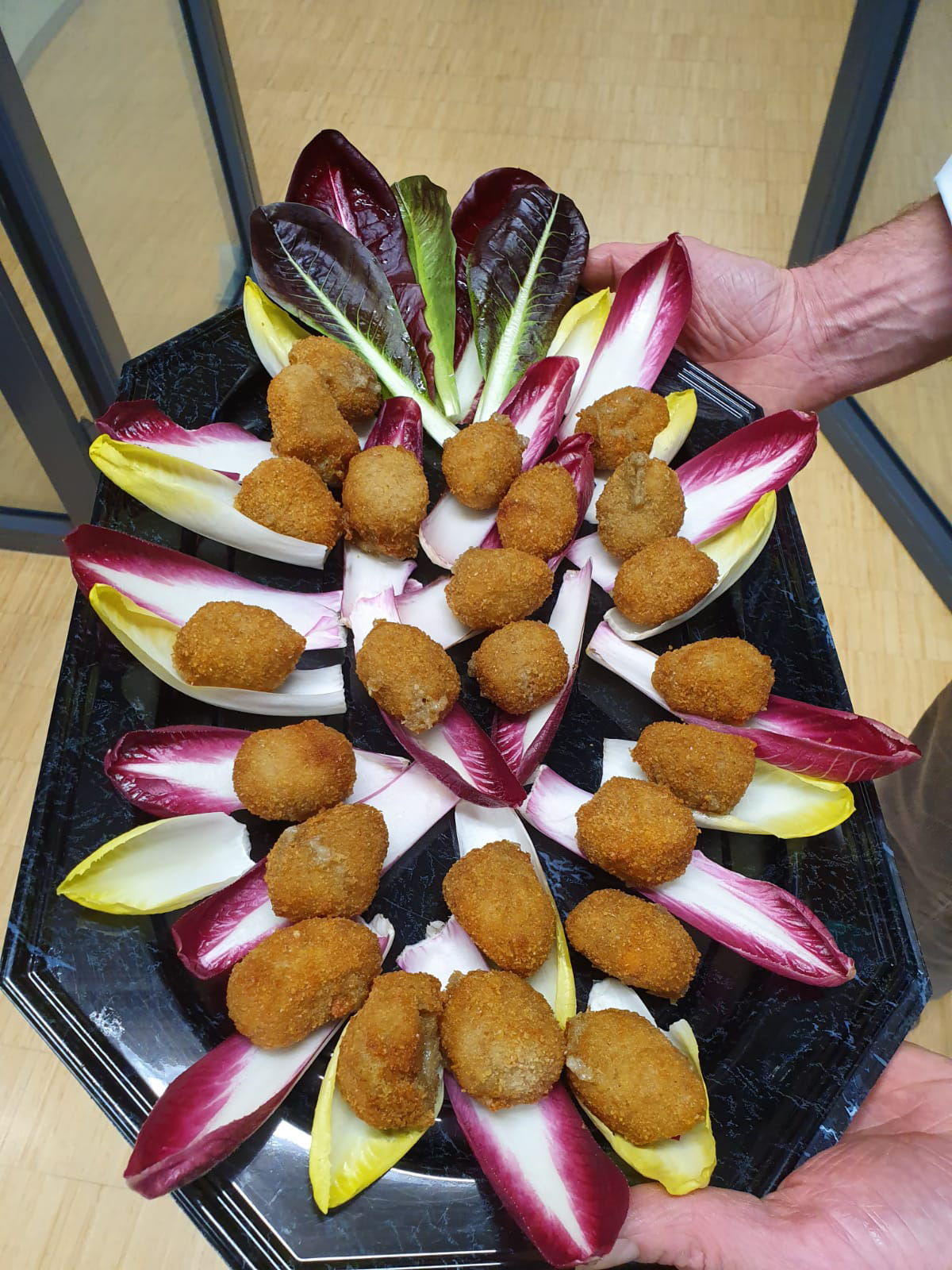High-quality applications sought for valuable Cichorium waste and by-product fractions
Producers of Cichorium crops produce significant quantities of by-products and waste fractions that have so far yielded little. However, they contain valuable components. Semi-finished products from the biorefinery of Belgian Endive roots can serve as an ingredient for food and drinks or as a raw material for the production of bioplastics. Within the CichOpt project, researchers are investigating how these waste fractions and by-products can provide real added value for the Belgian Endive grower in the future.


During the cultivation and processing of Belgian Endive, various waste fractions and by-products are produced: mainly forced Belgian Endive roots but also leaves that are removed from the head during cleaning. Within the CichOpt project, a group of European researchers is investigating the possibilities of creating added value for these waste fractions and by-products. They not only focus on Belgian Endive, but also on the waste fractions and by-products from other crops in the Cichorium genus, namely radicchio, endive and chicory.
Waste and by-products still underutilized
The cultivation of Belgian Endive in Belgium, the Netherlands, France and Germany involves large quantities of waste fractions and by-products . In Belgium alone, it is estimated that more than 50,000 tonnes of forced Belgian Endive roots are produced each year. A large proportion of this ends up in animal feed free of charge or for a small fee or is used as a raw material in biogas plants. Leaves left over after cleaning the Belgian Endive head and unsaleable heads are rarely if ever used for further purposes. The same applies to residues of the other Cichorium species, such as radicchio and endive trimmings, which now often also go to biogas plants or composting. The industrial extraction of inulin from chicory also produces a large amount of pulp, which is mainly valorised as animal feed.
CichOpt project goes for high value-added valorisation
The waste fractions and by-products of the listed Cichorium crops therefore provide no or only minimal added value for the farmer today. However, some of these waste fractions and by-products contain useful ingredients. The development of new applications is pressing. This should end in a positive story for the farmer. That is the goal of the CichOpt project. CichOpt stands for 'Optimal use and valorisation of Cichorium biomass flows'. This European project is coordinated by ILVO and within Flanders also has Inagro and the National Witloof Laboratory as a partner. The universities of Wageningen (the Netherlands) and Hohenheim (Germany) are also involved, as is the VTT Technical Research Centre of Finland.
Waste and by-products first screened for valuable components
One of the objectives of the CichOpt project is to obtain fractions that are enriched with the valuable components from the waste fractions and by-products by means of a biorefinery process that is as simple as possible. These fractions can then be used in new, high-quality applications. More specifically, we are interested in dietary fibre, sugar chains, sesquiterpene lactones and polyphenols. Dietary fibres are particularly interesting for applications in the food industry. The sugar chains can in turn serve as building blocks in 'green chemistry', such as the production of bioplastics. Sesquiterpene lactones are the bitter substances that are characteristic of crops from the Cichorium genus and, together with polyphenols, are known for a number of interesting bioactive properties, which makes them interesting not only for food and beverage applications, but also for the cosmetic and pharmaceutical sectors. Knowledge about the concentration of each of these components in the waste fractions and by-products of the various Cichorium crops is of great importance for further valorisation. Therefore, in a first phase of the project, a number of commercially relevant varieties of each of the Cichorium crops will be screened for these components in the different tissues (leaves, roots, hair roots). Each partner in the consortium has its own speciality. Within the CichOpt project, we combine these specific areas of expertise to produce semi-finished products in the most efficient way that can be used in certain high-value applications.
Biorefinery products as a functional food ingredient
ILVO focuses on the application of the semi-finished products from biorefinery as functional ingredients in food and beverages. They are interested in the purification and stabilization of dietary fibres and sugars, but also in the bioactive sesquiterpene lactones and polyphenols. Dietary fibres are a potential ingredient in the growing supply of plant-based foods (vegetarian burgers and spreads, bread ...). The sesquiterpene lactones, together with the polyphenols, are also interesting for their potentially positive effects on health. These antioxidants are known to remove free radicals that can cause damage to cells and tissues. But because of their typical bitter taste these components are also desirable in certain drinks such as beer and gin.
Sugar chains as raw material for bioplastics
The partners of the University of Hohenheim are very interested in the sugar chains present in the waste fractions and by-products . There, the researchers are in the process of fine-tuning the production process of hydroxymethylfurfural (HMF), using the sugars present in Cichorium waste streams. HMF is a raw material for the production of biomaterials (bioplastics). These biomaterials can be used in the production of e.g. packaging or clothing. Their research showed that shorter sugar chains are important to achieve an efficient purification process. Since both the field phase, storage and forcing have an influence on the final concentration of these shorter sugar chains in the forced Belgian Endive root, the influence of these factors for different varieties is investigated.
Antimicrobials for pharmaceuticals
In addition to their antioxidant properties, sesquiterpene lactones and polyphenols also have anti-microbial and anti-inflammatory properties. This also makes these components extremely interesting for their application in cosmetic and pharmaceutical products. Within CichOpt, the Finnish partner VTT will evaluate their application in cosmetic products. Within this framework, they are also investigating whether chicory hair roots can be used to produce and extract these bioactive components.
Targeted breeding possible using improved knowledge of compostion
Within the CichOpt project, Wageningen University carries out various DNA and molecular level analyses. These analyses are specifically aimed at mapping the high quality components in both the waste streams and the various plant tissues, and this for various varieties of Belgian Endive, red-leaved Belgian Endive, Friseline, chicory, radicchio and endive. From the results, the researchers will not only learn a lot about the presence and concentration of the high-quality metabolites themselves, but the collected information will also serve as a basis for more targeted breeding. For example, new varieties can be selected with specific flavours or with higher concentrations of specific components.
Costs and benefits will be mapped out
Launching new applications in practice will ultimately only be possible if they are economically profitable and also effectively create sustainable added value for the farmer. Important aspects in this respect include the cost of any transport of the waste fractions and by-products, the biorefinery process and further processing into end products. In order to get a good picture of the economic feasibility, the researchers carry out a technical-economic feasibility study in which all costs and benefits are taken into account as fully as possible. Specifically for Belgian Endive roots, all project partners are collecting information in the various chicory countries. This will enable them to map the geographical distribution and seasonal availability of forced Belgian Endive roots. As a result, the possible location and size of the required biorefinery unit can be better estimated. It is already a major advantage that within Europe Belgian Endive cultivation is mainly located in Belgium, France, the Netherlands and Germany and transport costs will therefore be relatively limited.
To be continued
For the entire Cichorium producing sector, the valorisation of existing waste fractions and by-products can provide a new source of income, which can improve profitability. The characterisation of the components influencing taste and at the same time having health-promoting effects may allow the creation of new outlets through targeted breeding of varieties. The best strategy for developing a suitable biorefinery process for the purification of high-value components has yet to be demonstrated. Which small-scale processing (possibly mobile) could be carried out on the farm and which processes would be better centralised, in larger units? Further research and a feasibility study will provide more insight into this. The CichOpt project runs until March 2021, so it will certainly be continued ...
Further information
This research was carried out as part of the ERA-NET FACCE SURPLUS 'CichOpt' project. FACCE SURPLUS received funding from the HORIZON 2020 research and innovation programme of the European Union (project 652615). At the Flemish level, the CichOpt project is funded by the Agency for Innovation and Entrepreneurship.
Partners in the CichOpt project include Institute for agriculture, fisheries and food research, Belgium - Flanders, Inagro vzw, Belgium - Flanders, Wageningen Plant Research, Netherlands, Nationale Proeftuin voor Witloof vzw, Belgium - Flanders, University of Hohenheim, Germany and VTT Technical Research Centre of Finland Ltd, Finland.
The Belgian Endive croquette was developed in cooperation with the Food from Food project. Food from Food is financed within the Flanders-Netherlands Interreg V programme, the cross-border cooperation programme with financial support from the European Regional Development Fund. This project runs from 1 January 2017 to 31 December 2020. More information can be found on www.grensregio.eu.

Contact
Dr. Bart Van Droogenbroeck,
Institute for agriculture, fisheries and food research, Belgium - Flanders
Email: Bart.VanDroogenbroeck@ilvo.vlaanderen.be
